
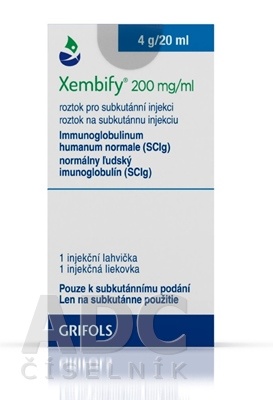
КСЕМБИФИ 200 мг/мл РАСТВОР ДЛЯ ПОДКОЖНЫХ ИНЪЕКЦИЙ

Спросите врача о рецепте на КСЕМБИФИ 200 мг/мл РАСТВОР ДЛЯ ПОДКОЖНЫХ ИНЪЕКЦИЙ

Инструкция по применению КСЕМБИФИ 200 мг/мл РАСТВОР ДЛЯ ПОДКОЖНЫХ ИНЪЕКЦИЙ
Введение
Прошпект: Информация для пациента
Хембифи 200мг/мл раствор для подкожного введения
Нормальная человеческая иммуноглобулина (IgSC)
Этот препарат подлежит дополнительному наблюдению, что ускорит обнаружение новой информации о его безопасности. Вы можете внести свой вклад, сообщая о побочных эффектах, которые у вас могут возникнуть. В конце раздела 4 содержится информация о том, как сообщать о этих побочных эффектах.
Прочитайте внимательно весь прошпект перед началом использования этого препарата, поскольку он содержит важную информацию для вас.
? Сохраните этот прошпект, поскольку вам может потребоваться снова прочитать его.
? Если у вас есть какие-либо сомнения, проконсультируйтесь с вашим врачом, фармацевтом или медсестрой.
? Этот препарат был назначен только вам, и не следует давать его другим людям, даже если у них такие же симптомы, как у вас, поскольку это может нанести им вред.
? Если вы испытываете побочные эффекты, проконсультируйтесь с вашим врачом, фармацевтом или медсестрой, даже если это побочные эффекты, которые не указаны в этом прошпекте. См. раздел 4.
Содержание прошпекта
- Что такое Хембифи и для чего он используется
- Что вам нужно знать перед началом использования Хембифи
- Как использовать Хембифи
- Возможные побочные эффекты
- Хранение Хембифи
- Содержание упаковки и дополнительная информация
1. Что такое Хембифи и для чего он используется
Что такое Хембифи
Хембифи - это раствор иммуноглобулинов человека (антител, в основном иммуноглобулина G) для помощи вашему организму в борьбе с инфекциями.
Хембифи содержит иммуноглобулины, полученные из плазмы здоровых людей. Иммуноглобулины помогают бороться с инфекциями, вызванными бактериями и вирусами. Препарат работает точно так же, как иммуноглобулины, присутствующие в человеческой крови, производимые иммунной системой.
Для чего используется Хембифи
Вы используете Хембифи, потому что у вас очень низкий уровень иммуноглобулинов из-за медицинского состояния, называемого иммунодефицитом. Инфузии Хембифи увеличивают уровень иммуноглобулина (антител), в частности иммуноглобулина G (IgG) в вашей крови до нормального уровня.
Этот препарат предназначен для взрослых, детей и подростков (0-18 лет), у которых недостаточно антител (заместительная терапия):
- Пациенты с синдромом первичной иммунодефициты (ПИД) с врожденной недостаточностью антител.
- Гипогаммаглобулинемия (заболевание, характеризующееся низким уровнем иммуноглобулинов в крови) и рецидивирующие бактериальные инфекции у пациентов с хронической лимфоцитарной лейкемией (рак крови, при котором производится слишком много белых кровяных телец) у которых профилактические антибиотики не дали результата.
- Гипогаммаглобулинемия и рецидивирующие бактериальные инфекции у пациентов с множественной миеломой (опухоль, образованная из клеток, полученных из костного мозга).
Гипогаммаглобулинемия у пациентов после трансплантации стволовых клеток (аллогенная трансплантация стволовых клеток гемопоэза, ТСГ), когда они получают стволовые клетки от другого человека.
2. Что вам нужно знать перед началом использования Хембифи
Не используйте Хембифи
? если вы аллергичны к нормальной человеческой иммуноглобулине или к любому другому компоненту этого препарата (включая раздел 6);
? если у вас была тяжелая аллергическая реакция (например, анафилаксия) на человеческую иммуноглобулину;
? если у вас есть антитела к иммуноглобулине A (IgA) в вашей крови. Это может произойти, если у вас есть дефицит IgA. Поскольку Хембифи содержит IgA, вы можете иметь аллергическую реакцию;
? путем введения в кровеносный сосуд (внутривенно) или в мышцу (внутримышечно).
Сообщите вашему врачу, фармацевту или медсестре перед инфузией Хембифи, если у вас когда-либо был побочный эффект, связанный с иммуноглобулиной или любым из ее компонентов.
Предостережения и меры предосторожности
Проконсультируйтесь с вашим врачом, фармацевтом или медсестрой перед началом использования Хембифи.
- Сообщите вашему врачу, если у вас есть история сердечно-сосудистых заболеваний, сосудистых заболеваний, тромба в кровеносном сосуде (например, инсульта, сердечного приступа или легочной эмболии), густой крови, диабета, высокого артериального давления, геморрагического или коагуляционного расстройства или если вы были иммобилизированы в течение некоторого времени. Сообщите вашему врачу, если вы принимаете эстрогены, обычно в качестве контрацептивов. У вас может быть более высокий риск развития тромба после инфузии Хембифи. Свяжитесь с вашим врачом немедленно, если у вас出现ят затруднения дыхания; боль в груди; боль и отек руки или ноги; или слабость или онемение на одной стороне тела. У вас может быть тромб в кровеносном сосуде.
- Свяжитесь с вашим врачом, если у вас появляются сильные головные боли, жесткость шеи, сонливость, лихорадка, повышенная чувствительность к свету, тошнота или рвота. Эти побочные эффекты могут появиться через несколько часов или даже дней после инфузии Хембифи. У вас может быть асептический менингит.
- Хембифи может вызывать проблемы с почками, включая почечную недостаточность. Сообщите вашему врачу, если у вас снижена функция почек.
- Хембифи может влиять на определенные анализы крови (серологические тесты). Всегда сообщайте вашему врачу, что вы проходите лечение Хембифи, прежде чем сдавать анализ крови.
Аллергические реакции
Аллергические реакции редки. Однако вы можете иметь аллергию на иммуноглобулины, не зная об этом. Аллергические реакции, такие как внезапное снижение артериального давления или анафилактический шок (внезапное снижение артериального давления с другими симптомами, такими как отек горла, затруднение дыхания и кожная сыпь), редки, но могут возникнуть偶ально, даже если у вас не было побочных эффектов от иммуноглобулинов в прошлом. У вас более высокий риск аллергических реакций, если у вас есть дефицит IgA с анти-IgA. Убедитесь, что вы сообщили вашему врачу, если у вас есть дефицит IgA. Хембифи содержит некоторое количество IgA, которое может увеличить риск аллергической реакции. См. раздел 4 этого прошпекта (Возможные побочные эффекты) для знакомства с признаками и симптомами аллергической реакции.
Риск передачи заболеваний
Хембифи очищается из человеческой плазмы, полученной от здоровых доноров. Когда вводятся биологические препараты, нельзя полностью исключить возможность передачи инфекционных заболеваний из-за передачи патогенов. Однако в случае продуктов, приготовленных из человеческой плазмы, риск передачи патогенов снижается за счет: (1) эпидемиологического контроля донорской популяции и отбора доноров путем медицинского интервью; (2) анализа индивидуальных донорских образцов и смесей плазмы для обнаружения маркеров вирусной инфекции; и (3) производственных процедур с доказанной способностью инактивировать/удалить патогены.
Несмотря на эти меры, когда вводятся препараты, приготовленные из человеческой крови или плазмы, нельзя полностью исключить возможность передачи инфекций. Это также относится к неизвестным или возникающим вирусам или другим типам инфекций.
Принятые меры считаются эффективными для вирусов с оболочкой, таких как вирус иммунодефицита человека (ВИЧ), вирус гепатита B и вирус гепатита C, и для необолоченных вирусов, таких как вирус гепатита A. Принятые меры могут иметь ограниченную ценность против необолоченных вирусов, таких как парвовирус B19.
Иммуноглобулины не были связаны с инфекциями гепатита A или парвовируса B19, возможно, потому что антитела против этих инфекций, содержащиеся в препарате, являются защитными.
Рекомендуется, чтобы каждый раз, когда вам вводится доза этого препарата, имя и номер партии препарата (указанные на этикетке и упаковке после "Партия") записывались для ведения учета использованных партий.
Дети и подростки
Предостережения и меры предосторожности применяются к взрослым, детям и подросткам.
Другие препараты и Хембифи
Сообщите вашему врачу или фармацевту, если вы принимаете, недавно принимали или можете принимать любой другой препарат.
Всегда вводите инфузию Хембифи отдельно, не смешивая ее с любым другим препаратом.
Если вы собираетесь быть привитым, сообщите врачу, что вы проходите лечение Хембифи. Хембифи может влиять на некоторые вакцины (живые вирусные вакцины), такие как вакцины против кори, свинки, краснухи и ветряной оспы. Вам может потребоваться подождать до 3 месяцев после получения Хембифи, прежде чем быть привитым. Для вакцины против кори вам может потребоваться подождать до 1 года.
Эти взаимодействия применяются к детям, взрослым и людям пожилого возраста.
Беременность, лактация и фертильность
Если вы беременны или кормите грудью, считаете, что можете быть беременной или планируете стать беременной, проконсультируйтесь с вашим врачом или фармацевтом перед использованием этого препарата.
Не проводились исследования Хембифи у беременных или кормящих женщин, и поэтому ваш врач или фармацевт будут руководить вами. Клинический опыт с иммуноглобулинами предполагает, что не ожидается вредного воздействия на беременность, плод или ребенка. Если вы кормите грудью, иммуноглобулины, содержащиеся в Хембифи, также могут присутствовать в грудном молоке. Таким образом, они могут защищать вашего ребенка от определенных инфекций. Клинический опыт с иммуноглобулинами предполагает, что не ожидается вредного воздействия на фертильность.
Вождение и использование машин
Ваша способность управлять транспортными средствами и использовать машины может быть нарушена некоторыми побочными эффектами, такими как головокружение, связанными с Хембифи. Если у вас出现ят побочные эффекты во время лечения, подождите, пока они не пройдут, прежде чем управлять транспортными средствами или использовать машины.
3. Как использовать Хембифи
Следуйте точно инструкциям по введению этого препарата, указанным вашим врачом. В случае сомнений проконсультируйтесь с вашим врачом снова.
Хембифи следует вводить под кожу (подкожное введение или СК).
Лечение Хембифи будет начато вашим врачом или медсестрой. Не начинайте лечение дома с Хембифи, пока не получите полные инструкции.
Доза
Ваш врач определит рекомендуемую дозу и схему введения. Ваш врач рассчитает правильную дозу для вас на основе вашего веса, любого предыдущего лечения, которое вы получали, и вашего ответа на лечение. Следуйте точно инструкциям по введению препарата, содержащимся в этом листке или указанным вашим врачом, фармацевтом или медсестрой. В случае сомнений спросите их.
Ваша первая доза может быть так называемой "загрузочной дозой", целью которой является быстрое увеличение уровня иммуноглобулина в вашей крови. Ваш врач определит, нужна ли вам "загрузочная доза" (для взрослых или детей) не менее 1-2,5 мл/кг веса тела. Вы можете получить эту загрузочную дозу, разделенную на несколько дней.
Вам будет введен Хембифи периодически, от ежедневного до одного раза в 2 недели; накопленная доза в месяц будет примерно 1,5-5 мл/кг веса тела. Ваш врач может скорректировать дозу на основе вашего ответа на лечение.
Не изменяйте эту дозу или интервал времени до следующей дозы без предварительной консультации с вашим врачом.
Если вы считаете, что должны получить другую дозу или хотите изменить схему введения, проконсультируйтесь с вашим врачом. Свяжитесь с вашим врачом, если вы забыли принять дозу.
Вам необходимо будет пройти регулярные анализы крови, чтобы измерить уровень иммуноглобулина в вашей крови. Поговорите с вашим врачом о графике.
Нет разницы между дозой для взрослых, включая людей пожилого возраста (65 лет и старше), и дозой для детей и младенцев, поскольку количество введенного Хембифи основано на весе тела.
Способ введения
Вы будете получать Хембифи через медленное подкожное введение в жировую ткань (подкожное введение). Хембифи будет введен с помощью насоса или инъектора. Подкожное введение для домашнего лечения должно быть начато и контролируемо медицинским специалистом с опытом в руководстве пациентами для домашнего лечения.
Вы (или ваш опекун) должны получить обучение по:
- использованию устройства для введения, например, шприца-насоса, если необходимо,
- использованию асептических методов введения (без микробов),
- ведению журнала лечения, и
- распознаванию и мерам, которые необходимо принять в случае серьезных побочных реакций.
Следуйте точно инструкциям вашего врача относительно дозы, скорости введения и схемы введения Хембифи, чтобы лечение было эффективным.
Места введения
Вводите Хембифи только подкожно. Вводите Хембифи в подкожную ткань в места, такие как
- живот,
- бедра,
- верхняя часть рук и
- боковая часть бедра.
При выборе мест введения избегайте: костных зон, видимых кровеносных сосудов, рубцов и любой зоны воспаления (раздражения) или инфекции. Чередуйте места при каждом введении.
При ваших первых двух введениях начните со скорости введения 10 мл в час на место введения. Если вы не испытываете побочных реакций (см. раздел 4), скорость введения можно увеличить каждые 10 минут до максимальной скорости 20 мл в час на место введения у детей и подростков и 25 мл в час на место введения у взрослых. После 2 сеансов введения скорость введения можно постепенно увеличить до 35 мл в час на место введения. Проконсультируйтесь с вашим врачом перед увеличением скорости введения.
Вы можете выполнять введение одновременно в нескольких местах, если они разделены не менее чем на 5 см. Взрослые могут разделить дозу между несколькими местами, особенно если объем превышает 30 мл. Нет ограничения на количество мест, которые можно использовать. Вы можете использовать более одного насоса для этого.
Инструкции по использованию
Подкожное введение для домашнего лечения должно быть начато и контролируемо медицинским специалистом с опытом в руководстве пациентами для домашнего лечения. Можно использовать подходящие насосы для подкожного введения иммуноглобулина. Пациент или опекун должен получить обучение по использованию насоса для введения, методам введения, ведению журнала лечения, распознаванию и мерам, которые необходимо принять в случае серьезных побочных реакций.
Следуйте следующим шагам и используйте асептическую технику для введения Хембифи.
Перед использованием дайте раствору достичь комнатной или телесной температуры (20-37°C). Это может занять 60 минут или более.
Не прикладывайте тепло и не помещайте в микроволновую печь.
Шаг1: Подготовка материалов
Соберите флакон(и) Хембифи, дополнительные материалы, контейнер для острых предметов, журнал/запись лечения пациента и насос(ы) для введения.
Шаг2: Очистка поверхности
Установите зону введения на чистой, плоской и непористой поверхности, такой как кухонный стол.
Избегайте использования пористых поверхностей, таких как дерево. Очистите поверхность с помощью спиртовой салфетки, выполняя круговое движение от центра кнаружи.
Шаг3: Мытье рук
Вымойте и хорошо высушите руки перед использованием Хембифи.
Ваш врач может порекомендовать вам использовать антибактериальное мыло или надевать перчатки.

Шаг4: Проверка флаконов
Жидкость в флаконе должна быть прозрачной или слегка опалесцирующей, бесцветной или иметь светло-желтый или бледно-коричневый цвет.
Не используйте флакон, если:
- раствор мутный или измененного цвета. Раствор должен быть прозрачным или слегка опалесцирующим, бесцветным или иметь светло-желтый или бледно-коричневый цвет.
- отсутствует защитная крышка или есть признаки вскрытия. Немедленно сообщите об этом вашему врачу.
- истек срок годности.
Шаг5: Удаление защитной крышки
Удалите защитную крышку с флакона, чтобы открыть центральную часть пробки.
Очистите пробку с помощью спирта и дайте ей высохнуть.

Шаг6: Перенос Хембифи из флакона(ов) в шприц
Не допускайте, чтобы ваши пальцы или другие предметы касались внутреннего штока поршня, наконечника шприца или других зон, которые могут вступать в контакт с раствором Хембифи. Убедитесь, что иглы имеют защитный колпачок до использования и что иглы и шприцы остаются в чистой зоне, созданной на шаге 2. Это называется "асептической техникой" для предотвращения попадания микробов в Хембифи.
Используя асептическую технику, присоедините каждую иглу к наконечнику шприца.
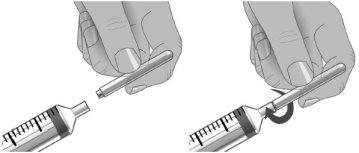
Шаг7: Подготовка шприца и извлечение раствора Хембифи в шприц
Удалите колпачок с иглы.
Потяните за поршень шприца до уровня, соответствующего количеству Хембифи, которое необходимо извлечь из флакона.
Поместите флакон Хембифи на плоскую и чистую поверхность и вставьте иглу в центр пробки флакона.
Введение воздуха в флакон. Количество воздуха должно соответствовать количеству Хембифи, которое необходимо извлечь.
Наклоните флакон и извлеките правильное количество Хембифи. Если необходимо несколько флаконов для получения правильной дозы, повторите шаги 4-7.
Введение сразу после переноса Хембифи из флакона в шприц.
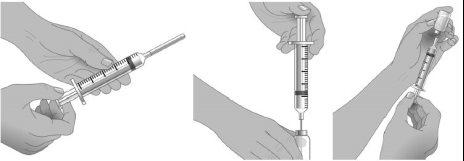
Шаг8: Подготовка насоса для введения
Следуйте инструкциям производителя насоса для подготовки насоса для введения, трубки для введения и соединительной трубки Y, если необходимо.
Пропитайте трубку для введения Хембифи, чтобы удалить воздух, оставшийся в трубке или игле. Для пропитки держите шприц в одной руке и иглу с колпачком трубки для введения в другой. Аккуратно нажмите на поршень, пока не увидите каплю Хембифи, выходящую из иглы.
Шаг9: Выбор количества и мест введения
Выберите одно или несколько мест введения в соответствии с указаниями вашего врача.
Количество и местоположение мест введения зависят от объема общей дозы.
Подходящими местами для введения являются: живот, бедра, верхняя часть рук и боковая часть бедра.
Избегайте: костных зон, видимых кровеносных сосудов, рубцов и любой зоны воспаления (раздражения) или инфекции.
Чередуйте места между будущими введениями.
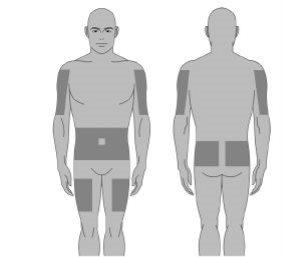
Шаг10: Подготовка места введения
Очистите место(а) введения с помощью стерильной спиртовой салфетки, начиная от центра каждого места введения и двигаясь кнаружи с круговым движением. Дайте место(а) введения высохнуть (не менее 30 секунд).
Перед введением места должны быть чистыми, сухими и разделенными не менее чем на 5 см.
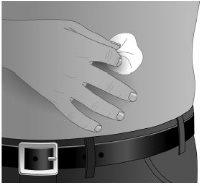
Шаг11: Вставка иглы
Захватите кожу между двумя пальцами (зажмите не менее 2,5 см кожи) и вставьте иглу под углом 90 градусов в подкожную ткань или жировую ткань.
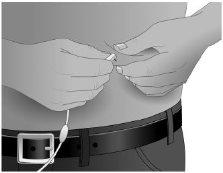
Шаг12: Проверка того, что игла не находится в кровеносном сосуде
После вставки каждой иглы в ткань (и перед введением) убедитесь, что вы не случайно вошли в кровеносный сосуд. Для этого подключите стерильный шприц к концу трубки для введения. Потяните за поршень шприца и наблюдайте, поступает ли кровь в трубку для введения.
Если вы видите кровь, удалите и утилизируйте иглу и трубку для введения.
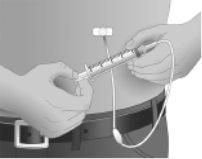
Повторите шаги пропитки и вставки иглы, используя новую иглу и трубку для введения, и новое место введения.
Зафиксируйте иглу на месте, положив стерильный бинт или прозрачную повязку на место.
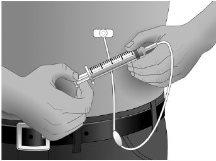
Шаг13: Повтор для других мест, если необходимо
Шаг14: Введение Хембифи
Введение Хембифи как можно скорее после подготовки.
Следуйте инструкциям производителя для заполнения трубки и использования насоса для введения.
Шаг15: После введения
Следуйте инструкциям производителя для выключения насоса.
Удалите и утилизируйте любой пластырь или ленту.
Аккуратно удалите иглу(ы) или катетер(ы), которые были введены.
Утилизируйте любой неиспользованный раствор в подходящем контейнере для отходов, согласно инструкциям.
Утилизируйте любой использованный оборудование для введения в подходящем контейнере для отходов.
Храните свои материалы в безопасном месте.
Следуйте инструкциям производителя для ухода за насосом для шприца.
Шаг16: Регистрация каждого введения
Удалите съемную этикетку с номером партии продукта с флакона Хембифи и используйте ее для заполнения записи пациента. Включите информацию о каждом введении, например:
- время и дата,
- доза,
- номер(а) партии,
- места введения и
- любая реакция.
Помните, что необходимо взять с собой журнал, когда вы посещаете вашего врача. Возможно, ваш врач попросит вас показать ему ваш журнал/запись лечения.
Сообщите вашему врачу о любой проблеме, которую вы испытываете во время введения. Позвоните вашему врачу, чтобы он сообщил вам о побочных реакциях.
Использование у пациентов пожилого возраста
Доза у пациентов пожилого возраста не считается другой, чем у пациентов в возрасте от 18 до 65 лет.
Использование у детей и подростков
Доза у детей и подростков (0-18 лет) не отличается от дозы у взрослых. У младенцев и детей можно менять место введения каждые 5-15 мл.
Если вы примете больше Хембифи, чем необходимо
Свяжитесь с вашим врачом, чтобы получить инструкции.
В случае передозировки или случайного введения немедленно проконсультируйтесь с вашим врачом или фармацевтом или позвоните в Центр токсикологической информации, телефон 91 562 04 20, указав препарат и количество, введенное.
Если вы забыли использовать Хембифи
Не принимайте двойную дозу, чтобы компенсировать пропущенные дозы. Свяжитесь с вашим врачом, чтобы получить инструкции.
Если у вас есть какие-либо другие вопросы о использовании этого препарата, спросите вашего врача.
4. Возможные побочные реакции
Как и все препараты, этот препарат может вызывать побочные реакции, хотя не все люди испытывают их.
Редко человеческие нормальные иммуноглобулины могут вызывать внезапное снижение артериального давления и, в отдельных случаях, анафилактический шок, даже если пациент не проявлял гиперчувствительность к предыдущему введению.
Признаки или симптомы этих редких аллергических реакций включают:
- чувство головокружения, шаткости или обморока;
- кожная сыпь и зуд, отек рта или горла, затруднение дыхания, свистящее дыхание;
- нарушение сердечного ритма, боль в груди, синюшность губ или пальцев рук и ног.
Если вы наблюдаете любой признак аллергической реакции или анафилаксии во время введения Хембифи, немедленно прекратите введение и свяжитесь с вашим врачом или обратитесь в ближайшую больницу. См. раздел 2 этого листка (Предостережения и меры предосторожности). Если вы наблюдаете любой из этих признаков во время введения Хембифи, когда его вводит медицинский специалист, немедленно сообщите об этом вашему врачу или медсестре. Он решит, следует ли уменьшить скорость введения или полностью прекратить его.
Могут возникать местные реакции в местах введения, такие как отек, боль, покраснение, индурация (твердый бугорок), местное тепло, зуд, синяки и кожная сыпь.
Хембифи может иногда вызывать озноб, головную боль, головокружение, лихорадку, рвоту, аллергические реакции, общее недомогание (тошноту), боль в суставах, низкое артериальное давление и умеренную боль в нижней части спины.
Следующие побочные реакции очень часто встречаются при использовании Хембифи (могут возникать у1 или более человек из каждых10):
? Местная реакция в месте введения
Следующие побочные реакции часто встречаются при использовании Хембифи (могут возникать у1 или более человек из каждых100):
? Головная боль
? Артралгия (боль в суставах)
? Боль в спине
? Ринит (насморк, чихание и заложенность носа)
? Диарея
? Тошнота
? Пирексия (лихорадка)
? Снижение уровня иммуноглобулина G в крови
? Зуд
? Папула (маленькая возвышенная область кожи)
Побочные реакции после выхода препарата на рынок
Во время послепродажного использования Хембифи были выявлены и сообщены следующие побочные реакции (ни одна из них не была тяжелой): одышка (затруднение дыхания), усталость, боль, тошнота, головная боль и местная реакция в месте введения, такая как эритема (покраснение) и отек. Не всегда возможно надежно оценить частоту этих реакций.
Сообщение о побочных реакциях
Если вы испытываете любой побочный эффект, проконсультируйтесь с вашим врачом, фармацевтом или медсестрой, даже если это возможные побочные эффекты, не указанные в этом листке. Вы также можете сообщить об этом напрямую через Испанскую систему фармакологического надзора за лекарствами для человека: www.notificaRAM.es.
Сообщая о побочных реакциях, вы можете внести свой вклад в предоставление более полной информации о безопасности этого препарата.
5. Хранение Хембифи
Хранить это лекарство в недоступном для детей месте.
- Хранить в холодильнике (при температуре между 2°C и 8°C).
Хембифи можно хранить при температуре не выше 25°C в течение максимум 6 месяцев в любой момент до даты истечения срока годности.
В день, когда лекарство было удалено из холодильника, необходимо написать в поле "Дата уничтожения", предоставленное на упаковке, дату 6 месяцев после этого момента или дату истечения срока годности, напечатанную на вкладыше упаковки, в зависимости от того, что наступит раньше.
Если лекарство хранится при комнатной температуре, не следует возвращать его в холодильник. Использовать лекарство до даты "Дата уничтожения" или уничтожить его.
- Не замораживать.
- Хранить флакон в наружной упаковке, чтобы защитить его от света.
- Ввести лекарство как можно скорее после переноса Хембифи из флакона в шприц.
Не использовать это лекарство после даты истечения срока годности, указанной на этикетке и упаковке.
Не использовать это лекарство, если вы заметили, что оно стало дисцветным, мутным, имеет осадок или было заморожено.
Лекарства не должны выбрасываться в канализацию или мусор. Утилизируйте упаковку и лекарства, которые вам больше не нужны, в пункте приема SIGRE в аптеке. Если у вас есть сомнения, спросите у вашего фармацевта, как утилизировать упаковку и лекарства, которые вам больше не нужны. Таким образом, вы поможете защитить окружающую среду.
6. Содержимое упаковки и дополнительная информация
Состав Хембифи
Активное вещество - нормальная человеческая иммуноглобулина (IgSC). 1 мл содержит 200 мг нормальной человеческой иммуноглобулины, из которых не менее 98% - IgG.
Процентное содержание субклассов IgG составляет примерно 62% IgG1, 30% IgG2, 4,3% IgG3 и 3,2% IgG4. Содержит некоторое количество IgA (не более 160 микрограммов/мл).
Остальные компоненты - глицин (E 640), полисорбат 80 (E 433) и вода для инъекционных препаратов.
Внешний вид продукта и содержимое упаковки
Хембифи - это раствор для подкожного введения. Раствор прозрачный или слегка опалесцирующий, бесцветный или светло-желтый или светло-коричневый.
Хембифи выпускается в упаковке и содержится в стеклянном флаконе с пробкой, алюминиевой крышкой, пластиковой крышкой и защитной печатью, обеспечивающей целостность упаковки.
Хембифи выпускается в упаковках размером
1 или 10 флаконов, содержащих 1 г нормальной человеческой иммуноглобулины в 5 мл раствора для подкожного введения
1, 10 или 20 флаконов, содержащих 2 г нормальной человеческой иммуноглобулины в 10 мл раствора для подкожного введения
1 или 20 флаконов, содержащих 4 г нормальной человеческой иммуноглобулины в 20 мл раствора для подкожного введения
1 или 10 флаконов, содержащих 10 г нормальной человеческой иммуноглобулины в 50 мл раствора для подкожного введения
Каждая упаковка содержит 1, 10 или 20 флаконов Хембифи и 1 инструкцию.
Возможно, что будут продаваться только некоторые размеры упаковок.
Владелец разрешения на маркетинг и ответственный за производство
Институт Грифолс, С.А.
Кан Гваск, 2 - Паретс дель Вальес
08150 Барселона - Испания
Дата последнего пересмотра этого листка: Май 2024
Другие источники информации
Подробная информация о этом лекарстве доступна на сайте Испанского агентства по лекарствам и медицинским продуктам (AEMPS) (http://www.aemps.gob.es/)
- Страна регистрации
- Активное вещество
- Требуется рецептДа
- Производитель
- Информация носит справочный характер и не является медицинской рекомендацией. Перед приемом любых препаратов проконсультируйтесь с врачом. Oladoctor не несет ответственности за медицинские решения, принятые на основе этого контента.
- Аналоги КСЕМБИФИ 200 мг/мл РАСТВОР ДЛЯ ПОДКОЖНЫХ ИНЪЕКЦИЙФорма выпуска: ИНЪЕКЦИОННЫЙ РАСТВОР, 165 мг/млАктивное вещество: immunoglobulins, normal human, for extravascular adm.Производитель: Octapharma S.A.Требуется рецептФорма выпуска: ИНЪЕКЦИОННЫЙ РАСТВОР, 200 мг/млАктивное вещество: immunoglobulins, normal human, for extravascular adm.Производитель: Baxalta Innovations GmbhТребуется рецептФорма выпуска: ИНЪЕКЦИОННЫЙ РАСТВОР, 200 мг/млАктивное вещество: immunoglobulins, normal human, for extravascular adm.Производитель: Csl Behring GmbhТребуется рецепт
Аналоги КСЕМБИФИ 200 мг/мл РАСТВОР ДЛЯ ПОДКОЖНЫХ ИНЪЕКЦИЙ в других странах
Лучшие аналоги с тем же действующим веществом и терапевтическим эффектом.
Аналог КСЕМБИФИ 200 мг/мл РАСТВОР ДЛЯ ПОДКОЖНЫХ ИНЪЕКЦИЙ в Polónia
Аналог КСЕМБИФИ 200 мг/мл РАСТВОР ДЛЯ ПОДКОЖНЫХ ИНЪЕКЦИЙ в Ukraine
Врачи онлайн по КСЕМБИФИ 200 мг/мл РАСТВОР ДЛЯ ПОДКОЖНЫХ ИНЪЕКЦИЙ
Консультация по дозировке, побочным эффектам, взаимодействиям, противопоказаниям и продлению рецепта на КСЕМБИФИ 200 мг/мл РАСТВОР ДЛЯ ПОДКОЖНЫХ ИНЪЕКЦИЙ – по решению врача и с учетом местных правил.














